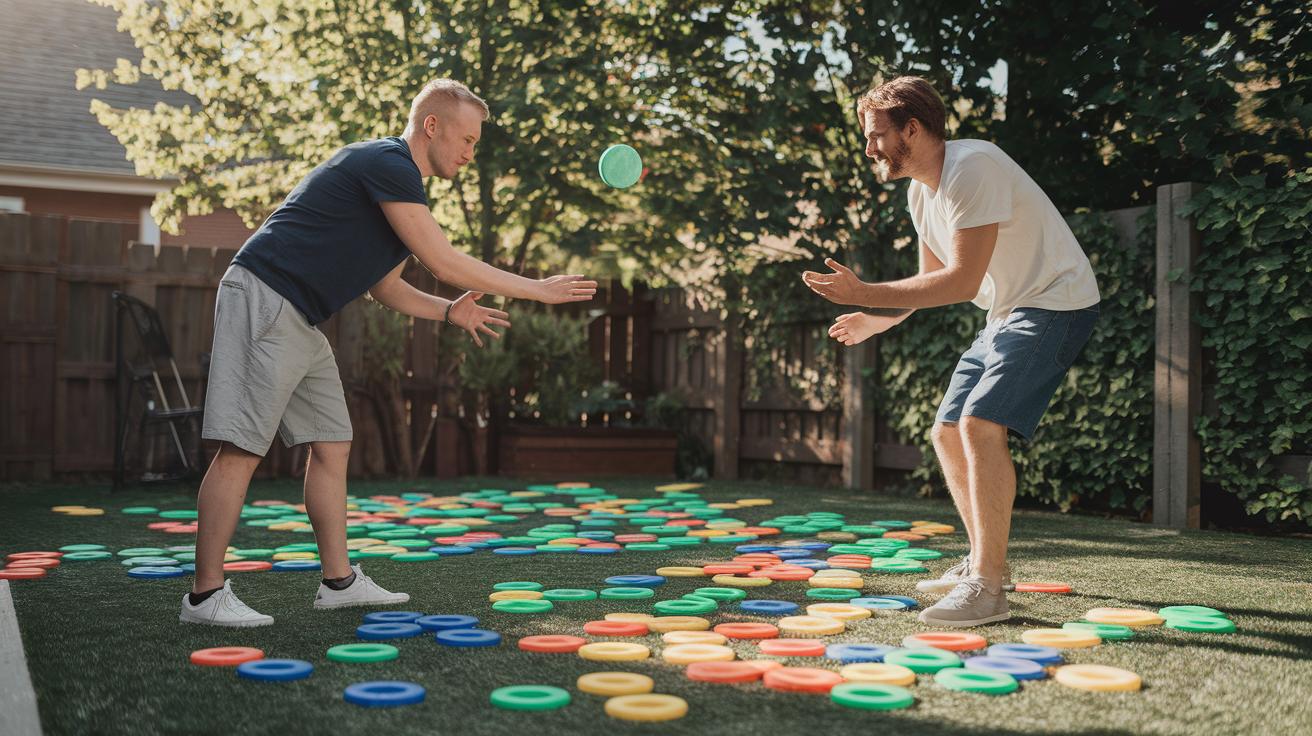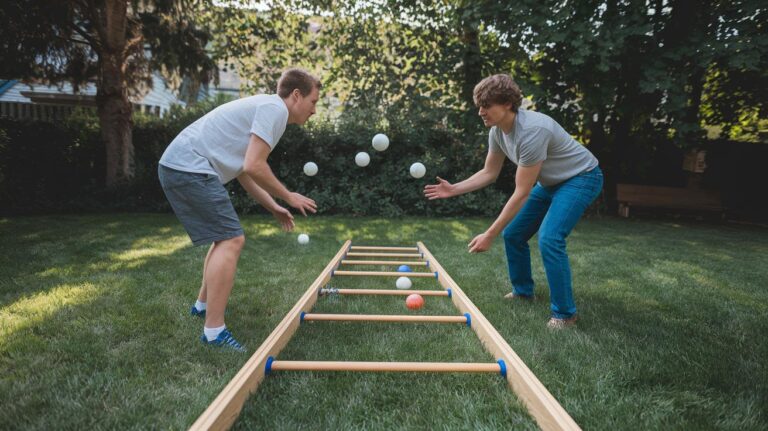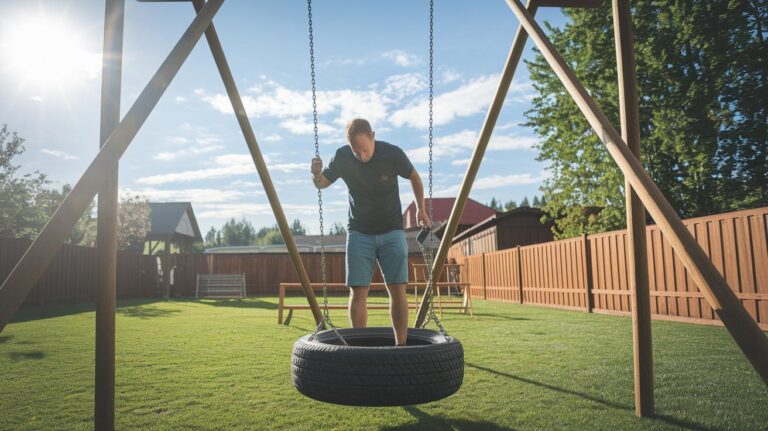Washers Toss Game Rules Amazing Setup and Scoring
Ever had a lazy afternoon turn into a fierce washer toss (ring-toss game) battle?
Just tweak a couple rules, and your backyard becomes a mini arena.
It’s as simple as grabbing flat metal washers (2.5-inch rings) and two wooden boards with holes (think big beanbag boards).
By the way, my cat naps on ours so watch for stray paws.
Lay the boards about 10 feet apart (about two adult steps).
Mark a foul line with chalk or tape so everyone tosses from the same spot.
Then lean in, find your rhythm, and give it a toss.
Hear that crisp clink on the wood? That sound makes everything feel electric.
Scoring’s easy.
A washer in the hole is 3 points.
Landing on the board but outside the hole is 1 point.
Go to 21, but win by two.
These quick tweaks keep the game fast, fair, and way more fun each round.
Understanding Official Washers Toss Game Rules
So here’s how washers toss works: you need a set of flat metal rings called washers (about 2 inches across and 3 ounces each) and two wooden or coated boards with a 2.5-inch hole. The boards sit on a level spot about 20 feet apart for grown-ups. For kids or casual play, pull them in closer, around 10 to 15 feet. By the way, my dog once chased a stray washer off the board…oops.
You and your partner each take turns tossing two washers toward the other board. You’ll hear that satisfying clink when a washer lands on the board. Slide it right through the hole and it’s even sweeter.
A hole shot scores 3 points. A washer on the board scores 1. A miss is 0. But here’s the trick: you only count the difference between the teams’ points. So if you score a hole (3) and they land on the board (1), you net 2 points.
The side that wins a round tosses first next time. Keep going until one team gets to 21 points with at least a 2-point lead. If it’s tied 20-20, play on until someone pulls ahead by two. Trust me, that stretch gets everyone cheering.
Scorekeepers usually grab pen and paper or a little chalkboard by the boards. It helps avoid “No, you had 12!” arguments.
Don’t step past the foul line (20 feet from the target board). If you do, that throw is worth zero, even if it lands in the hole. Toss out of turn? Also zero. Foul washers stay where they land until you tally scores, so they can even cancel out an opponent’s shot.
Make sure your foul-line marker is easy to see. Agree on who throws first. Then relax and focus on your best shot, not rule squabbles.
For other fun toss-game setups, check out outdoor ladder toss game guide.
| Landing Position | Points Awarded |
|---|---|
| Washer through hole (“washer”) | 3 |
| Washer on board | 1 |
| Miss | 0 |
Equipment and Court Layout in Washers Toss Game Rules
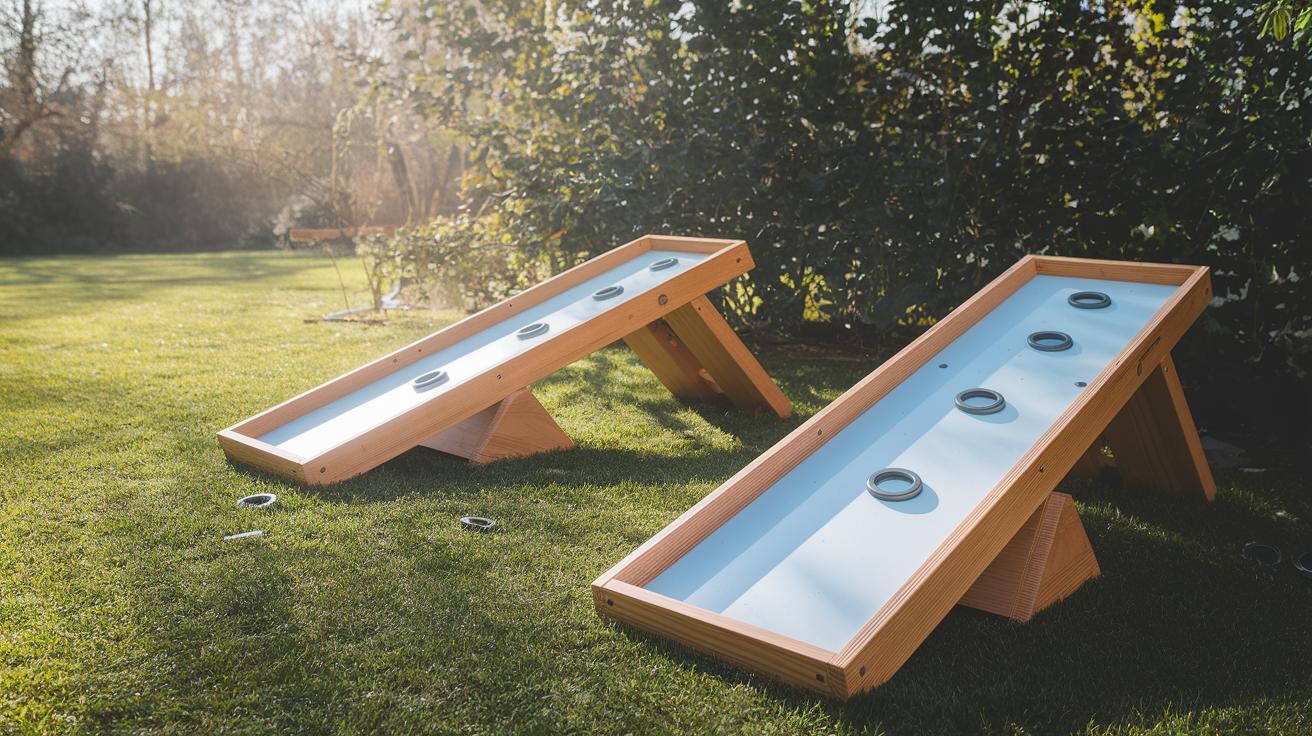
Most boards (the wooden platforms with a 6-inch hole for tossing washers) are made of pine or cedar. You can almost feel the fine wood grain under your fingertips. Some friends even use metal or plastic boards coated with a slick weatherproof finish (a thin layer that keeps rain and sun from warping them). I once left mine out during a surprise summer shower, wiped it down, and it looked brand new.
And then there are the distance markers – little stakes you stick in the ground to set your tossing line. Perfect for kids: try 10 to 12 feet for shorter throws, or bump it up to 15 feet if they’re feeling brave. By the way, these kits are a breeze to pack. The boards fold flat and fit right in the back of your car. Ready for the next backyard cookout?
Scoring System in Washers Toss Game Rules
And here’s the scoop on scoring. You stand at the board – feeling the warm wood underfoot and hearing the soft clink of each metal washer. A toss can slip through the hole (ringer – a washer that goes through the hole) for 3 points. It might land on the board (on-board landing – a washer resting on the board) for 1 point. Miss the board and you score zero.
After both players toss two washers, you compare your totals. Only the side with the higher total takes points – the other side gets none. The winner of the round tosses first in the next round.
First, cancel out matching washers. Pair ringers against ringers and on-board landings against on-board landings so those cancel each other out to zero. Then look at what’s left. Subtract the lower total from the higher one to find your round score.
For example, say you still have two ringers (6 points) and your opponent has one on-board landing (1 point). Subtract 1 from 6 and you get 5 points. Jot it on a chalkboard edge, mark it in your notebook, or tap it into a scoring app. By the way, my dog always thinks the tossed washers are his toys – um, it’s a game changer.
Keep playing until someone reaches 21 points with at least a two-point lead. Tied at 20-20? Just keep going until someone pulls ahead by two points. Have fun!
Turn Sequence, Fouls, and Win Conditions in Washers Toss Game Rules
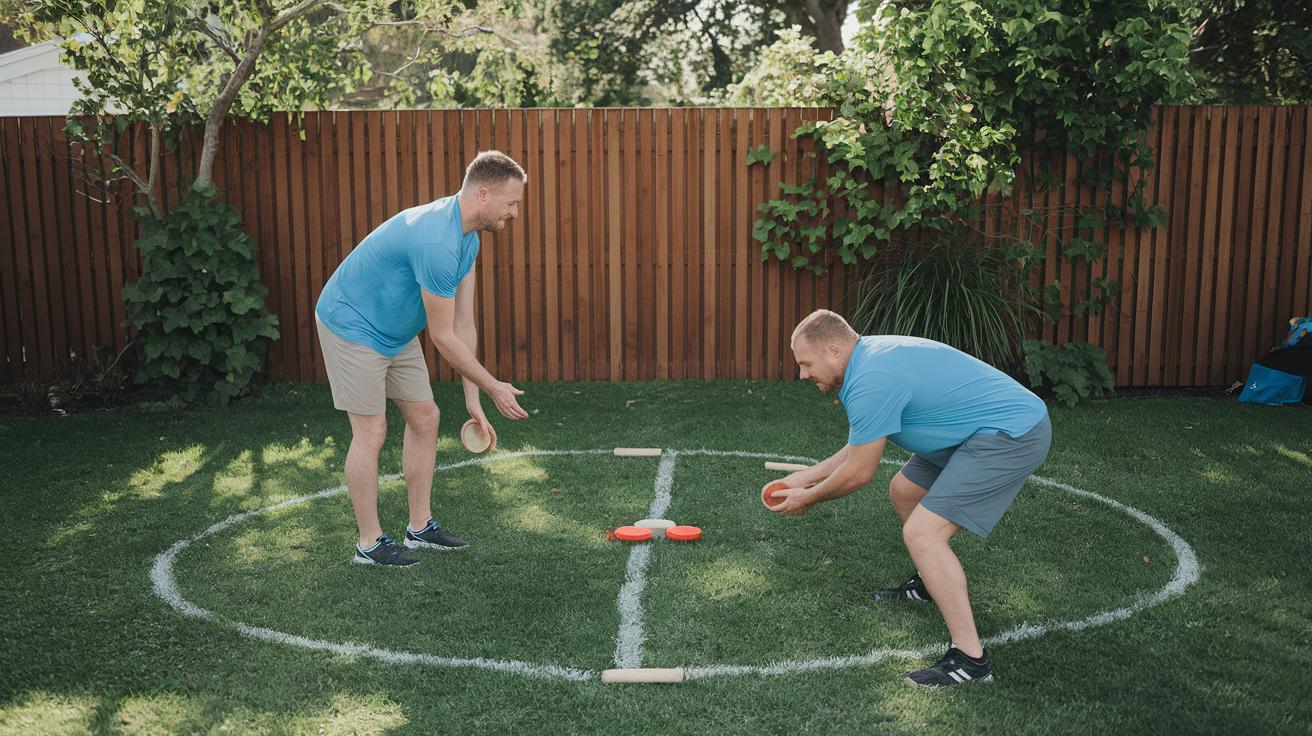
Have you ever heard the clink of a metal washer? These washers (small smooth metal discs) land in a sandy pit that feels warm under your feet. We each get two washers per round. The player who scored highest last round goes first.
Oops, if your washer rolls past the foul line (the line you must stand behind), it’s an automatic zero. Same if you toss out of turn. We leave that washer on the pit while we tally points, so nobody sneaks it back in later.
You can play singles, just you and me, two washers each, or doubles, where teams of two take turns tossing four washers. It’s like doubling the fun and the cheers!
We’re shooting for 21 points, but here’s the twist: you need a two-point lead to win. So if it’s 21 to 20, we keep going until someone wins by two. Keeps us on the edge, right?
Washers Toss Game Rules Amazing Setup and Scoring
Want a quick twist? Move your tossing line closer. For little kids or indoor play, slide the boards in to about 10 to 15 feet instead of the usual 20 feet. It feels more fun when everyone can reach the target.
Feeling daring? Swap in bigger or smaller metal washers (flat metal rings) to change how they fly. You can even drill the pit holes wider or tighter so landing a washer is easier or tougher. It’s a simple fix that spices up every game.
If dew or a light shower makes the board slick, grab a towel and give it a wipe. Or tuck your boards under a tarp so they don’t feel like an ice rink mid-toss. By the way, I once left mine out in a downpour – oops, warped right away.
Some folks brush on a quick coat of outdoor sealant (a waterproof coating) to keep boards strong through sun and rain. It helps them stay smooth and flat season after season.
Ready to race? Go to 15 points for a snack-break game or take it up to 31 points and play until twilight. You could even keep score on a chalkboard and call it best-of-25 or pick a surprise number to keep things playful. Let latecomers jump in at 10 points so nobody feels left out.
Local toss leagues sometimes have their own house rules. You might see raised platforms, a changed pit height, or a set distance that’s just a bit shorter or longer. Indoors, swap wooden boards for chalk lines on your garage floor and use soft foam washers (padded rings) to keep the clatter down. Sideboard setups – leaned boards on a step – work great in tight spaces or when you want a lighter-touch game inside.
Strategy and Technique Tips for Washers Toss Game

Grab a washer (that small metal disc you toss) and hold it between your thumb and curled fingers. Feel the cool edge against your palm and keep your grip relaxed. Stand with your feet shoulder width apart, weight balanced, knees slightly bent. Let your arm swing from the elbow like a gentle pendulum, and find the same release point every toss.
It’s tempting to go for a ringer (washer through the hole), right? But sometimes landing on the board flat (an on-board shot) can cancel your opponent’s points. Early on, aim two washers close to the hole’s rim.
Later, after you’ve claimed prime real estate, go for those three-pointers. And if they’ve already scored two ringers, a well-placed board shot can bump one off.
Here’s a fun practice routine:
• Mark spots at 10, 15, and 20 feet.
• Toss five washers at each spot and count how many land on the board or in the hole.
• Try three power levels, soft, medium, hard, to hit the hole’s front edge, middle, and back.
• Finally, place two washers on the board and practice knocking them off to clear your opponent’s shots.
Have you ever watched a washer spin in the air, tumbling just before it lands? Oops, I once flubbed my release and sent a washer skidding into the grass. But hey, that’s how you learn, so grab a set, head outside, and happy tossing!
Final Words
In the action, you’ve seen how to pick gear, set your court, and track points using metal washers, pits, and a simple table.
We covered scoring, a 3-point ringer, 1-point on-board, zero for misses, and the back-and-forth toss order with foul basics.
We also shared tweaks like shorter distances, custom point goals, and grip drills for better aim.
With these washers toss game rules in your pocket, you’re ready to play with confidence and have fun.
FAQ
What equipment do I need to play the washers toss game?
The washers toss game requires metal washers about 2 inches in diameter (3 ounces each) and two target pits or boards featuring 2.5-inch holes, plus a level surface and foul-line markers.
How do I set up a regulation washers toss court?
A regulation court places two pits flat on level ground 20 feet apart, with foul lines at that same distance from each target. Casual play can shorten distance to 10–15 feet.
How is scoring calculated in the washers toss game?
Scoring is calculated by awarding each washer through the hole three points, on-board landings one point, and misses zero points. Only the round’s point difference counts toward the match total.
What is cancellation scoring in washers toss?
Cancellation scoring in washers toss cancels opposing washers with equal value before tallying the remaining point difference. This keeps rounds strategic and prevents both sides from scoring for the same landing.
How do turns work and what counts as a foul?
Players alternate tossing two washers each round, with the previous round’s high scorer throwing first. Stepping past the foul line or tossing out of turn results in a zero-point foul for that washer.
How do I win a washers toss match?
Winning a washers toss match means reaching 21 points with at least a two-point lead. Tied games can go into sudden-death style extensions until one player or team leads by two.
Can I adjust rules or distance for casual play?
Casual play often reduces pit distance to 10–15 feet, swaps in different washer sizes or hole diameters, and changes point targets (like 15 or 31) to fit backyard gatherings or youth games.
What are some quick strategy tips for better tosses?
Key strategy tips include using a consistent grip and release point, aiming on-board landings early to build points, practicing accuracy drills at varied distances, and targeting opponent washers to trigger cancellation scoring.

